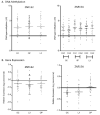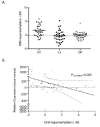Unique DNA methylation loci distinguish anatomic site and HPV status in head and neck squamous cell carcinoma
- PMID: 23894057
- PMCID: PMC3892374
- DOI: 10.1158/1078-0432.CCR-12-3280
Unique DNA methylation loci distinguish anatomic site and HPV status in head and neck squamous cell carcinoma
Abstract
Purpose: We have used a genome-wide approach to identify novel differentially methylated CpG dinucleotides that are seen in different anatomic sites of head and neck squamous cell carcinoma (HNSCC), as well as those that might be related to HPV status in the oropharynx.
Experimental design: We conducted genome-wide DNA methylation profiling of primary tumor samples and corresponding adjacent mucosa from 118 HNSCC patients undergoing treatment at Montefiore Medical Center, Bronx, NY, using the Illumina HumanMethylation27 beadchip. For each matched tissue set, we measured differentially methylated CpG loci using a change in methylation level (M-value).
Results: When datasets were individually analyzed by anatomic site of the primary tumor, we identified 293 differentially methylated CpG loci in oral cavity squamous cell carcinoma (SCC), 219 differentially methylated CpG loci in laryngeal SCC, and 460 differentially methylated in oropharyngeal SCC. A subset of these differentially methylated CpG loci was common across all anatomic sites of HNSCC. Stratification by HPV status revealed a significantly higher number of differentially methylated CpG loci in HPV+ patients.
Conclusion: Novel epigenetic biomarkers derived from clinical HNSCC specimens can be used as molecular classifiers of this disease, revealing many new avenues of investigation for this disease.
©2013 AACR.
Figures



Similar articles
-
Epigenetic changes in the CDKN2A locus are associated with differential expression of P16INK4A and P14ARF in HPV-positive oropharyngeal squamous cell carcinoma.Cancer Med. 2015 Mar;4(3):342-53. doi: 10.1002/cam4.374. Epub 2015 Jan 26. Cancer Med. 2015. PMID: 25619363 Free PMC article.
-
Identification of human papillomavirus (HPV) 16 DNA integration and the ensuing patterns of methylation in HPV-associated head and neck squamous cell carcinoma cell lines.Int J Cancer. 2017 Apr 1;140(7):1571-1580. doi: 10.1002/ijc.30589. Epub 2017 Jan 9. Int J Cancer. 2017. PMID: 28006857 Free PMC article.
-
Unique DNA methylation signature in HPV-positive head and neck squamous cell carcinomas.Genome Med. 2017 Apr 5;9(1):33. doi: 10.1186/s13073-017-0419-z. Genome Med. 2017. PMID: 28381277 Free PMC article.
-
Review: Head and neck squamous cell carcinoma in sub-Saharan Africa.Malawi Med J. 2015 Sep;27(3):79-87. doi: 10.4314/mmj.v27i3.2. Malawi Med J. 2015. PMID: 26715951 Free PMC article. Review.
-
HPV Integration in Head and Neck Squamous Cell Carcinomas: Cause and Consequence.Recent Results Cancer Res. 2017;206:57-72. doi: 10.1007/978-3-319-43580-0_4. Recent Results Cancer Res. 2017. PMID: 27699529 Review.
Cited by
-
DNA Methylation and HPV-Associated Head and Neck Cancer.Microorganisms. 2021 Apr 10;9(4):801. doi: 10.3390/microorganisms9040801. Microorganisms. 2021. PMID: 33920277 Free PMC article. Review.
-
Zinc Finger Proteins in Head and Neck Squamous Cell Carcinomas: ZNF540 May Serve as a Biomarker.Curr Oncol. 2022 Dec 16;29(12):9896-9915. doi: 10.3390/curroncol29120779. Curr Oncol. 2022. PMID: 36547193 Free PMC article.
-
Recurrent patterns of DNA methylation in the ZNF154, CASP8, and VHL promoters across a wide spectrum of human solid epithelial tumors and cancer cell lines.Epigenetics. 2013 Dec;8(12):1355-72. doi: 10.4161/epi.26701. Epub 2013 Oct 22. Epigenetics. 2013. PMID: 24149212 Free PMC article.
-
Metabolic Phase I (CYPs) and Phase II (GSTs) Gene Polymorphisms and Their Interaction with Environmental Factors in Nasopharyngeal Cancer from the Ethnic Population of Northeast India.Pathol Oncol Res. 2019 Jan;25(1):33-44. doi: 10.1007/s12253-017-0309-0. Epub 2017 Sep 26. Pathol Oncol Res. 2019. PMID: 28952035
-
Analysis of Ugandan cervical carcinomas identifies human papillomavirus clade-specific epigenome and transcriptome landscapes.Nat Genet. 2020 Aug;52(8):800-810. doi: 10.1038/s41588-020-0673-7. Epub 2020 Aug 3. Nat Genet. 2020. PMID: 32747824 Free PMC article.
References
-
- Parkin DM, Bray F, Ferlay J, Pisani P. Global cancer statistics, 2002. CA: a cancer journal for clinicians. 2005;55:74–108. - PubMed
-
- Belbin TJ, Singh B, Barber I, Socci N, Wenig B, Smith R, et al. Molecular classification of head and neck squamous cell carcinoma using cDNA microarrays. Cancer research. 2002;62:1184–90. - PubMed
-
- Takes RP, Baatenburg de Jong RJ, Schuuring E, Hermans J, Vis AA, Litvinov SV, et al. Markers for assessment of nodal metastasis in laryngeal carcinoma. Archives of otolaryngology--head & neck surgery. 1997;123:412–9. - PubMed
-
- Jemal A, Siegel R, Ward E, Hao Y, Xu J, Murray T, et al. Cancer statistics, 2008. CA: a cancer journal for clinicians. 2008;58:71–96. - PubMed
-
- Ha PK, Califano JA. Promoter methylation and inactivation of tumour-suppressor genes in oral squamous-cell carcinoma. The lancet oncology. 2006;7:77–82. - PubMed
Publication types
MeSH terms
Substances
Grants and funding
LinkOut - more resources
Full Text Sources
Other Literature Sources
Medical
Research Materials
Miscellaneous

